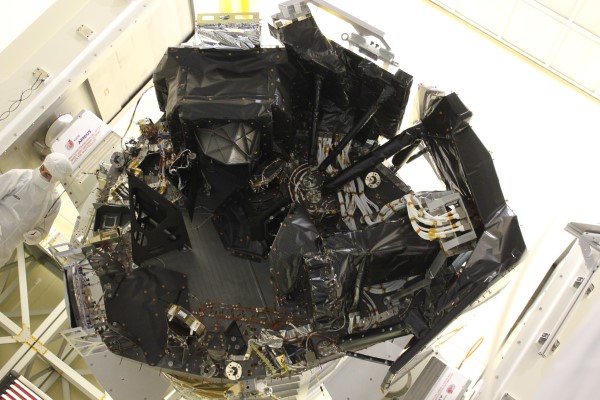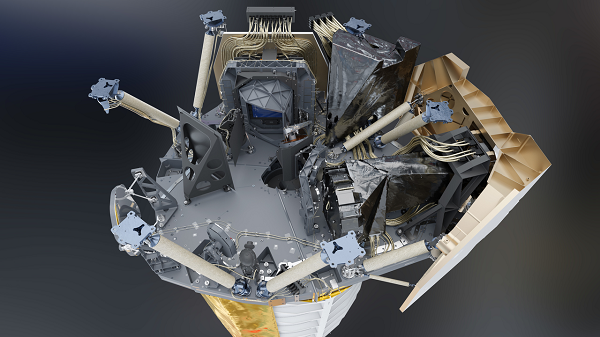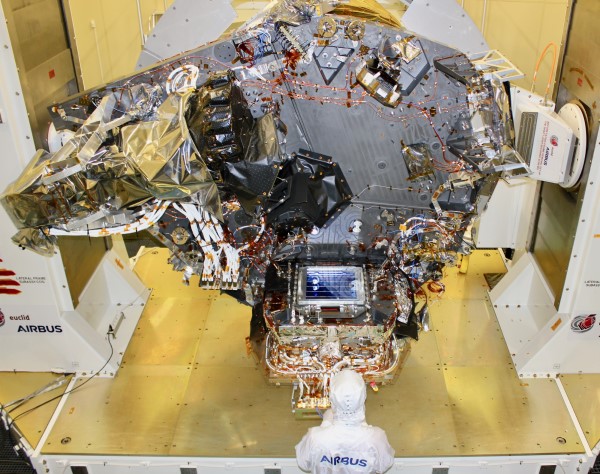Euclid's optical and infrared instruments integrated in spacecraft
21 December 2020
The optical and infrared instruments of Euclid, ESA's mission to study dark energy and dark matter in space, have passed their qualification and acceptance reviews and are now fully integrated into the spacecraft's payload module. This marks an important step forward in the assembly of the Euclid space telescope, which is scheduled for launch in 2022. |
| The Euclid payload module. Credit: Airbus Defence and Space - Toulouse |
The two Euclid instruments, the visible imager (VIS) and the near infrared spectrometer and photometer (NISP), were integrated onto the payload module of the spacecraft by Airbus Defence and Space in Toulouse, France. This module is built up from a silicon baseplate, containing the two instruments on one side, and the main mirror of the telescope on the other.
"It has been a complicated process to design and build the module," explains Giuseppe Racca, ESA's Euclid project manager. "Because the large baseplate is fully made out of silicon carbide, a ceramic material had to be moulded to accommodate the instruments at an extreme precision. Due to its large size it consists of four pieces that were combined as one. We are very happy that assembling and alignment of the optics and instruments have now been finalised."
 |
| CAD model of Euclid payload module. Credit: Airbus Defence and Space - Toulouse |
The visible and infrared instruments are crucial to measure both the shapes and redshift of distant galaxies and clusters of galaxies. This will enable scientists to reconstruct the past 10 billion years of the Universe's expansion history, and investigate the mysterious dark matter and dark energy that are thought to dominate the Universe.
After the successful integration of both instruments and the telescope, the so-called 'cold units', the payload module will be shipped to Centre Spatial de Liège, Belgium in April 2021. There, the instruments will be tested for optical compatibility and performance at the operating temperatures in space (ranging from -193°C to +17°C).
"We want to make sure that the instruments perform as predicted. Therefore, we will perform tests in a thermal vacuum chamber that can simulate the conditions of space as well as possible on Earth," says René Laureijs, ESA's project scientist for Euclid.
 |
| Euclid payload with the visual instrument exposed. Credit: Airbus Defence and Space - Toulouse |
Also present at the testing site in Belgium will be the service module panel containing the so-called 'warm units' such as computers and power supplies.
Once compatibility and performance tests show that everything is working as expected, the payload module and warm units panel will be shipped to Thales Alenia Space in Torino, Italy, where they will be integrated to form the final, finished spacecraft. Then, another round of tests will ensure that everything is working together properly. At that point, the spacecraft is essentially finished, and ready for launch.
Launch is currently scheduled for the second half of 2022 from Europe's spaceport, Kourou, French Guiana. Euclid will be orbiting the second Sun-Earth Lagrangian Point (L2), which is located 1.5 million kilometres directly 'behind' the Earth as viewed from the Sun.
About the Euclid instruments
Within ESA's overall coordination, the Euclid instruments were designed and built by the Euclid Consortium, a collaboration of nationally funded institutes responsible for the definition of the scientific mission and the provision of the scientific instruments and data processing. The VIS instrument was built by a consortium of nationally funded institutes led by Mullard Space Science Laboratory (MSSL), University College London, UK. The NISP instrument was built by a consortium of nationally funded institutes led by the Laboratoire d'Astrophysique de Marseille (LAM) in France; its detectors are provided by NASA.
For further information please contact:
Giuseppe Racca
Euclid Project Manager
Directorate of Science
European Space Agency
Email: giuseppe.racca![]() esa.int
esa.int
René Laureijs
Euclid Project Scientist
Directorate of Science
European Space Agency
Email: rene.laureijs![]() esa.int
esa.int



